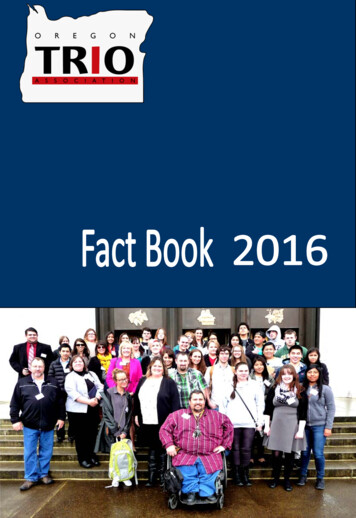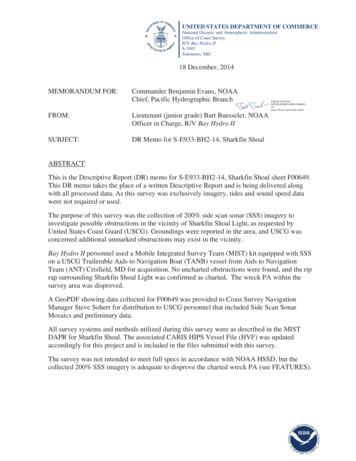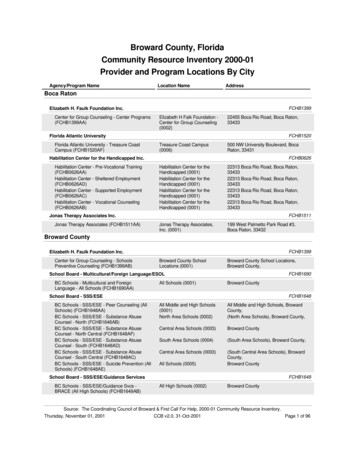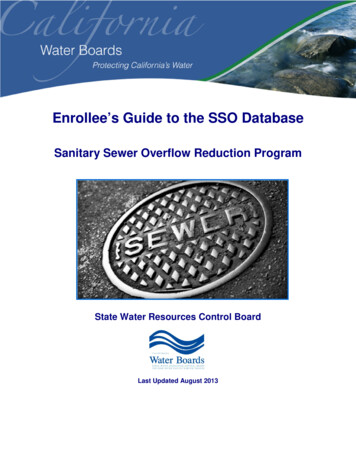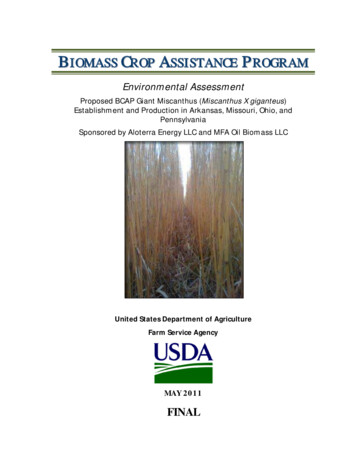
Transcription
BIOMASS CROP ASSISTANCE PROGRAMEnvironmental AssessmentProposed BCAP Giant Miscanthus (Miscanthus X giganteus)Establishment and Production in Arkansas, Missouri, Ohio, andPennsylvaniaSponsored by Aloterra Energy LLC and MFA Oil Biomass LLCUnited States Department of AgricultureFarm Service AgencyMAY 2011FINAL
MITIGATIED FINDING OF NO SIGNIFICANT IMPACTMITIGATED FINDING OF NO SIGNIFICANT IMPACTENVIRONMENTAL ASSESSMENTProposed BCAP Giant Miscanthus Establishment and Production in Arkansas, Missouri, Ohio andPennsylvaniaFarm Service AgencyU.S. Department of AgricultureThe United States Department of Agriculture Farm Service Agency (FSA) on behalf of theCommodity Credit Corporation (CCC) has prepared an Environmental Assessment (EA) toevaluate the environmental consequences associated with establishing Biomass CropAssistance Program (BCAP) project areas that support the establishment and production ofgiant miscanthus (Miscanthus x giganteus) on 50,000 acres per proposed project area(200,000 acres total) by 2014.The BCAP is a new program authorized by the Food,Conservation, and Energy Act of 2008 (2008 Farm Bill) that provides financial assistance tocontract producers in approved project areas for the establishment and production ofperennial bioenergy crops and annual bioenergy crops that show exceptional promise forproducing bioenergy or biofuels that preserve natural resources and that are not primarilygrown for food or animal feed.The purpose of the Proposed Action is to support the establishment and production of giantmiscanthus as a crop for energy production to be grown by BCAP participants in the projectareas proposed in Arkansas, Missouri, Ohio, and Pennsylvania. The need for the ProposedAction is to provide renewable biomass feedstock to a Biomass Conversion Facility (BCF)for use in energy production within and potentially outside the immediate region(s).PROPOSED ACTIONAloterra Energy LLC and MFA Oil Biomass LLC (Project Sponsors) are proposing that FSAestablish BCAP project areas that support the establishment and production of giantmiscanthus on 50,000 acres per proposed project area (200,000 total acres) by 2014, withcrop longevity of 20 to 30 years. The acreage projected to be enrolled within the proposedproject areas are marginal croplands and pastureland. The proposed project areas arelocated in four states in four distinct proposed project areas.Missouri contains twoproposed project areas; Columbia and Aurora. Arkansas contains one proposed projectarea, Paragould. Ohio and Pennsylvania contain the final proposed project area, Ashtabula.Each proposed project area is named for the approximate location of the BCF that will beFINAL - Environmental Assessment Giant Miscanthus Establishment and ProductionI
MITIGATIED FINDING OF NO SIGNIFICANT IMPACTutilized to process the giant miscanthus biomass into pellets to be shipped to other facilitiesor users for use in bioenergy products. Each proposed project area was developed as anapproximate 50-mile radius from the approximate location of each BCF. The establishmentand production of giant miscanthus would begin with centralized propagation acres on eachfarm, which would be distributed to plantation acres during the next growing season. Duringthis planting season (2011), this initial establishment would require a centralized locationwithin each proposed project area with center-pivot irrigation due to the late planting thisgrowing season. This centralized propagation area for the entire proposed project areawould only occur for the 2011 planting season; all other planting season would follow the onfarm model with the initial establishment of propagation acres, followed by plantation acresthe following growing season. Equipment to be used to establish giant miscanthus would bemodified equipment from existing perennial grass industries. Equipment used to harvestand bale giant miscanthus would be similar to existing types of agricultural machinery usedfor hay crops; however, they would need to be more heavy-duty due to the increasedbiomass amounts being harvested and baled.REASONS FOR MITIGATED FINDING OF NO SIGNIFICANT IMPACTIn consideration of the analysis documented in the EA and the reasons outlined in thisMitigated Finding of No Significant Impact (FONSI), the Proposed Action would notconstitute a major Federal action that would significantly affect the human environment.Therefore, an environmental impact statement will not be prepared. The determination isbased on the following:1. The Proposed Action as outlined in the EA would provide minor beneficial effects tosocioeconomics, soil resources, and water quality and quantity of the local areas dueto a diversified agricultural production, establishment of perennial vegetation onhighly erodible soils, and estimated higher water use efficiency of the species to beestablished.2. The Proposed Action could result in minor negative effects from land use changesassociated with marginal and idle croplands and pasturelands returning toagricultural production; vegetation composition on pasturelands, which in turn couldalter wildlife habitat, and water quantity due to increased water use of the specieswhen compared to annual species, such as traditional row crops. These potentialnegative effects would be minimized through the use of the Mitigation and MonitoringPlan, described in the EA.FINAL - Environmental Assessment Giant Miscanthus Establishment and ProductionII
MITIGATIED FINDING OF NO SIGNIFICANT IMPACT3. The Proposed Action would require site specific environmental screening for eachproducer contract initiated with FSA for inclusion as a producer within the proposedproject areas, which would identify field level resources that would be need to beavoided or the effects could be minimized through mitigation efforts as described inthe EA.4. Potential beneficial and adverse impacts of implementing the Proposed Action havebeen fully considered within the EA. No significant adverse direct or indirect effectswere identified, based on the resource analyses provided.5. The Proposed Action would not involve effects to the quality of the humanenvironment that are likely to be highly controversial.6. The Proposed Action would not establish a precedent for future actions withsignificant effects and does not represent a decision in principle about a futureconsideration.7. The Proposed Action does not result in cumulative significant impacts whenconsidered with other actions that also individually have insignificant impacts.Cumulative impacts of implementing the Proposed Action were determined to be notsignificant.8. The Proposed Action would not have adverse effects on threatened or endangeredspecies or designated critical habitat since site specific analyses would beundertaken for each producer contract within each proposed BCAP project area toavoid adverse effects to these protected species.9. The Proposed Action does not threaten a violation of Federal, State, or local law orrequirements imposed for the protection of the environment.OVERVIEW OF THE MITIGATION AND MONITORING PLANTo avoid more than minor adverse effects to the human and natural environment, amitigation and monitoring plan was developed to address each of the resource areasanalyzed in detail within the EA. One of the primary components of the Mitigation andMonitoring Plan is producer education. This education component, to be held twice annuallyfor active producers with an orientation program for new producers, outlines best practicestandards across an array of resource areas and topics to ensure effective establishmentand management of the giant miscanthus fields. In addition to the educational components,FINAL - Environmental Assessment Giant Miscanthus Establishment and ProductionIII
MITIGATIED FINDING OF NO SIGNIFICANT IMPACTproducers would be required to submit annual reports to the Project Sponsors detailingmany aspects of production and allows for a greater understanding of how this species willgrow in a production setting.More specifically, FSA with cooperation from the NaturalResource Conservation Service (NRCS), the Agricultural Research Service (ARS) and theProject Sponsors are proposing the following mitigation and monitoring measures. Thesemonitoring and mitigation measures have been developed based on the prevailing literatureand in some cases, conservative estimates relating to existing standards for otherconservation programs and practices, but not specific to giant miscanthus. Biannual Producer meetings to discuss new developments in production,management, pest/disease treatment, and eradication; New Producer orientation to discuss production methods, management activities,potential for spread of giant miscanthus, treatment methods, and responsibilities,pest/disease identification, treatment methods, and responsibilities, eradicationmethods, if necessary, and reporting requirements; Producer Conservation Plans to include site specific best management practices(BMPs), which could include, but not be limited to, NRCS Conservation PracticeStandards (CPS) for soil erosion, pesticide use and application, fertilizer use andapplication, and other relevant areas for each specific site; Setbacks/buffers to manage the giant miscanthus stand and to prevent unintentionalspread of the giant miscanthus shall follow all local, State, or Federal regulations forcontainment of biomass plantings in existence at the time of the development of theproducer’s Conservation Plan or through an amendment of the Conservation Planinitiated by the producer and approved by FSA and NRCS, if determined appropriatefor the site-specific conditions. If no such guidance exists, minimum procedures toprevent unintentional spread of giant miscanthus shall include:oEstablish or maintain a minimum 25 feet of setback/border around a giantmiscanthus stand, unless the field is adjacent to existing cropland or activelymanaged pasture with the same operator.oSetback/border areas may be planted to an annual row crop such as corn orsoybeans; may be planted to a site-adapted, perennial cool-season or warmseason forage or turf grass; may be kept in existing vegetation; or kept clearby disking, rotovating, or treating with a non-selective burn down herbicide atFINAL - Environmental Assessment Giant Miscanthus Establishment and ProductionIV
MITIGATIED FINDING OF NO SIGNIFICANT IMPACTleast once a year. The method used may be dependent on slope and thepotential for erosion. The use of only the sterile variety of giant miscanthus cultivar known as the “IllinoisClone” for producers included within the proposed project areas; all Illinois Clonecultivars must be approved for planting under Aloterra’s membership through theOhio Seed Improvement Association’s Quality Assurance program; The initiation of a seed sampling program to determine the on-going sterility of seedsproduced from the BCAP acres within the project areas.The seed samplingprogram includes recommended actions, including eradication, if a seed samplereturns viable seed. Exclusion of planting giant miscanthus on certain acreage within approximately 1,300feet from any known Miscanthus sinensis or Miscanthus sacchariflorus to limit thepotential for cross-pollination resulting in viable seed. Exclusion of planting giant miscanthus on certain acreage within the project areas,depending upon certain site-specific conditions, like those lands subject to frequentflooding events; Monitoring program developed to identify (1) spread of giant miscanthus outside ofplanted fields with notification provided to both USDA and the Project Sponsors assoon as possible after identification of the issue, (2) identification of diseases andpests with notification provided to the Project Sponsors as soon as possible afteridentification of the issue; and (3) wildlife use or changes in use, all to be included inthe annual producer reporting; a USDA representative will conduct an annual fieldvisit to monitor the site and to look for potential spread of giant miscanthus beyondthe site; the USDA will work with local weed control districts to provide additionalmonitoring/evaluation of these sites as appropriate; and Annual producer reporting, which would include land use tracking with the averageand total size of enrolled fields; prior land use; rationale for land use change; spreadof giant miscanthus outside of planted fields; any pests/diseases identification; theuse of pesticides/herbicides to control unwanted spread of giant miscanthus orpests/diseases; BMP and CPS incorporated into field management, such as erosioncontrol structures or materials, vegetative barriers, etc.; fertilizer usage andapplication methods; and cost data.FINAL - Environmental Assessment Giant Miscanthus Establishment and ProductionV
MITIGATIED FINDING OF NO SIGNIFICANT IMPACTDETERMINATIONIn accordance with the National Environmental Policy Act and FSA's environmentalregulations at 7 Code of Federal Regulations (CFR) part 799 implementing the regulationsof the Council on Environmental Quality, 40 CFR parts 1500-1508, I find the ProposedAction and associated mitigation measures do not constitute a major Federal actionsignificantly affecting the quality of the human environment. Therefore, no environmentalimpact statement will be prepared.,Acting Executive Vice President,Commodity Credit Corporation, andActing Administrator,Farm Service AgencyFINAL - Environmental Assessment Giant Miscanthus Establishment and ProductionVI
EXECUTIVE SUMMARYEXECUTIVE SUMMARYINTRODUCTION AND BACKGROUNDThe U.S. Department of Agriculture (USDA) Commodity Credit Corporation (CCC)implements the Biomass Crop Assistance Program (BCAP) authorized by the Food,Conservation, and Energy Act of 2008 (the 2008 Farm Bill). On October 27, 2010, the CCCpublished the Record of Decision (ROD) for the BCAP Final Programmatic EnvironmentalImpact Statement (PEIS) and the BCAP Final Rule (7 Code of Federal Regulations [CFR]Part 1450) in the Federal Register (FR 75:207, 65995-66007; 66202-66243). As part of themitigation measures detailed in the ROD, each project proposal is subject to a NationalEnvironmental Policy Act (NEPA) (Public Law [PL] 91-190, 42 U.S. Code [USC] 4321 etseq.) analysis prior to approval of the project area proposal.The initial environmentalevaluation of a project area proposal is developed through the completion of Forms BCAP19, BCAP-20, BCAP-21, and BCAP-22 and supporting information.After this initialevaluation FSA can conclude that no additional environmental analyses are applicable dueto no potential for the proposed BCAP activity to significantly impact the environment or thatadditional environmental analyses in the form of an environmental assessment (EA) orenvironmental impact statement (EIS) are necessary, depending upon the potential level ofsignificance.This EA analyzes the proposed establishment of BCAP project areas supporting theproposed establishment and production of giant miscanthus hybrid (Miscanthus Xgiganteus) by Aloterra Energy LLC and MFA Oil Biomass LLC (Project Sponsors) inArkansas, Missouri, Ohio, and Pennsylvania, which is being completed to meet therequirements of the NEPA environmental evaluation of the BCAP or to determine if an EISwould be required.PURPOSE AND NEEDThe primary purpose of BCAP is to promote the cultivation of perennial bioenergy crops andannual bioenergy crops that show exceptional promise for producing bioenergy or biofuelsthat preserve natural resources and that are not primarily grown for food or animal feed.The purpose of the Proposed Action is to support the establishment and production of giantmiscanthus as a crop for energy production to be grown by BCAP participants in the projectareas proposed in Arkansas, Missouri, Ohio, and Pennsylvania. The need for the ProposedFINAL - Environmental Assessment Giant Miscanthus Establishment and ProductionES- 1 -
EXECUTIVE SUMMARYAction is to provide renewable biomass feedstock to a Biomass Conversion Facility (BCF)for use in energy production within and potentially outside the immediate region(s).ALTERNATIVESAs part of the BCAP Project Area Selection Process, the Project Sponsors develop aproposal application for submittal to FSA. Prior to this submittal, the Project Sponsors havelikely determined the economic feasibility of their proposal, including developing alternativesfor location and crop species. The Project Sponsors developed selection criteria to meet theoverall purpose and need for the Proposed Action, the establishment and production of giantmiscanthus as a dedicated energy crop for energy production under the incentives of theBCAP. As part of the alternatives development process the Project Sponsors analyzed bothalternative crops and alternative locations for the proposed project areas; however, each ofthese was determined not to be feasible. As such, this EA is analyzing the implementationof the Proposed Action or the selection of the No Action Alternative, that FSA would notestablish the proposed project areas supporting the establishment and production of giantmiscanthus.PROPOSED ACTIONAloterra Energy LLC and MFA Oil Biomass LLC (Project Sponsors) are proposing that FSAestablish BCAP project areas that support the establishment and production of giantmiscanthus on 50,000 acres per proposed project area (200,000 total acres) by 2014, withcrop longevity of 20 to 30 years. The acreage projected to be enrolled within the proposedproject areas are marginal croplands and pastureland. The proposed project areas arelocated in four states in four distinct proposed project areas.Missouri contains twoproposed project areas; Columbia and Aurora. Arkansas contains one proposed projectarea, Paragould. Ohio and Pennsylvania contain the final proposed project area, Ashtabula.Each proposed project area is named for the approximate location of the BCF that will beutilized to process the giant miscanthus biomass into pellets to be shipped to other facilitiesor users for use in bioenergy products. Each proposed project area was developed as anapproximate 50-mile radius from the approximate location of each BCF. The establishmentand production of giant miscanthus would begin with centralized propagation acres on eachfarm, which would be distributed to plantation acres during the next growing season. Duringthis planting season (2011), this initial establishment would require a centralized locationwithin each proposed project area with center-pivot irrigation due to the timing of planting.FINAL - Environmental Assessment Giant Miscanthus Establishment and ProductionES- 2 -
EXECUTIVE SUMMARYThis centralized propagation area for the entire proposed project area would only occur inthe 2011 planting season; all other planting seasons would follow the on-farm model withthe initial establishment of propagation acres, followed by plantation acres the followinggrowing season. No irrigation will be required after 2011.Equipment to be used to establish giant miscanthus would be modified equipment fromexisting perennial grass industries. Equipment used to harvest and bale giant miscanthuswould be similar to existing types of agricultural machinery used for hay crops; however,they would need to be more heavy-duty due to the increased biomass amounts beingharvested and baled. Table ES-1 lists the proposed propagation and planting schedulewithin each of the proposed project areas, totaling 50,000 acres per proposed project areaby 2014, which is the maximum planting goal under this action.Table ES-1.Proposed Giant Miscanthus Acres Added by Growing Season 2011-20142011201220132014PropagationTotal AcresProject AreaAcres RangeTotal Giant Miscanthus Acres ,50028,40050,000NOTE: 2011 is the only year that will have only propagation acres planted, total additional acreage per yearincludes both propagation acres and plantation acres (2012-2014)ENVIRONMENTAL CONSEQUENCESTable ES-2 provides a tabular summary of the potential effects from both the ProposedAction and No Action Alternative. Implementing the Proposed Action would result in minorpositive and negative effects to the local and regional area; however, many of these effectswould be minimized through the use of the Mitigation and Monitoring Plan. FSA has aframework for defining the components of the Mitigation and Monitoring Plan.TheMitigation and Monitoring Plan is included in section 6.0 of this document.The Proposed Action would result in additional diversified income for a participatingproducers, as well as technical assistance from the Project Sponsors in the production andharvesting of giant miscanthus. The Project Sponsors have proposed a BCF in each of theproposed project areas ensuring that producers will have a demand for their products. Also,ancillary agricultural services should expect an increase due to the Project Sponsors goal ofprimarily contracting idle acres and not active cropland. The Proposed Action would resultin a changed local landscape with the addition of the giant miscanthus fields; however, mostcontract acreage would range in size between 38 to 100 acres.FINAL - Environmental Assessment Giant Miscanthus Establishment and ProductionES- 3 -
EXECUTIVE SUMMARYTable ES-2.Resource AreaSocioeconomicsLand UseBiological ResourcesVegetationWildlifeProtected SpeciesSoil ResourcesWater Quality/QuantityWater QualityWater QuantityNote: positiveComparison of the AlternativesProposed ActionNo Action Alternative minor0- minor0- minor- minor0 /- minor /- minor /- minor- negative0000/- minor000 neutralThe Mitigation and Monitoring Plan would be used to ensure that adverse effects from thisnew crop are minimized or avoided. Similarly, minor negative effects would be anticipatedfor biological diversity as pastureland is converted into giant miscanthus croplands. TheMitigation and Monitoring Plan would be essential to provide mechanisms such asreasonable and economically feasible buffers and field edges to provide for continuedwildlife and vegetative diversity in these areas. Recent research has indicated that giantmiscanthus is susceptible to some plant pests; the Mitigation and Monitoring Planmonitoring and buffer efforts would be essential to ensure that any occurrence is identifiedand treated early to avoid transmission to local croplands, such as corn.Giant miscanthus, which has an extensive perennial root system, would be anticipated tohave positive effects on soil retention, soil organic matter, and soil carbon sequestration.Water quality should improve relative to other crops typically grown in the project areas dueto improved nutrient uptake, low fertilizer requirements, and reduced sediment transport.Also, due to its growth patterns, giant miscanthus would be anticipated to require morewater than corn grown for grain, but less water than grass hay and improved pasture. Themajority of the acres that enroll in the program are expected to be pastureland and idlecropland. The project may also see some conversion of irrigated lands to the non-irrigatedmiscanthus, which will reduce regional water use from those irrigated acres. The plant hasmuch higher water use efficiency, generating high amounts of biomass per volume of waterconsumed, indicating it uses rainfall efficiently.The No Action Alternative would result in no adverse effects to the local and regional areasince there would be no giant miscanthus planted in any of the proposed project areas asdescribed in this BCAP Project Proposal. However, the No Action Alternative would notFINAL - Environmental Assessment Giant Miscanthus Establishment and ProductionES- 4 -
EXECUTIVE SUMMARYassist in meeting the overall goal of BCAP, which is to develop dedicated energy crops forconversion to bioenergy.DATA GAPS IN CURRENT UNITED STATES ESTABLISHMENT AND PRODUCTIONGiant miscanthus is a new agronomic crop species in the United States, and also stillrelatively new in Europe, where the oldest cultivation areas are approximately 30 years oldor less. The Miscanthus genus was introduced to the United States over 100 years ago inornamental plantings and was first described by Beal in 1896 in the Grasses of NorthAmerica.Several universities (i.e., University of Illinois, Mississippi State University,University of Wisconsin, Michigan State University, and the University of Georgia) in theUnited States are currently cultivating giant miscanthus on a trial basis or conductingresearch on giant miscanthus or the Miscanthus genus. Additionally, large-scale acreagesof giant miscanthus have not been cultivated in the United States; although commercialproduction of giant miscanthus for bioenergy production in co-fired systems have beenestablished within the last few years in the United Kingdom. Given, that giant miscanthushas only been grown in large-scale trials in Europe, the data on giant miscanthus planting inthe United States is limited.In light of the lack of data applicable to the proposed project areas, an adaptive Mitigationand Monitoring Plan has been developed, which includes best management practices(BMPs) for the establishment and production of giant miscanthus.These BMPs aredesigned to ensure avoidance and/or minimization of potential effects to the immediateenvironment and the larger landscape.The Mitigation and Monitoring Plan is a livingdocument that is highly dependent on routine monitoring of the fields to determine thesuccess of giant miscanthus plantings, its overall effects to the immediate environment, andany potential effects to the larger landscape based on observation and measurement. Thisdocument contains information on appropriate and effective eradication methods that wouldbe updated over time as new data become available. Likewise, other metrics or observablemeasurements will be adapted over time based on past observations, new researchfindings, and new regulations.The following information related to the growth and production of giant miscanthus in theUnited States has been found to be lacking complete detail. . Potential effects to socioeconomics are focused on the information provided in thepro forma analyses of the Project Sponsors. Data from Europe indicates a high costFINAL - Environmental Assessment Giant Miscanthus Establishment and ProductionES- 5 -
EXECUTIVE SUMMARYof establishment due to the vegetative propagation of the species; however, theBCAP combined with the model undertaken by the Project Sponsors and technicalassistance to be provided to producers addresses most of these concerns. Landscape scale analyses of giant miscanthus are generally lacking since therehave not been any commercial-scale field trials in the United States. Literature documenting the potential for invasiveness of the fertile species of theMiscanthus genus has been discussed along with documentation supporting thatgiant miscanthus should not be considered invasive due to its sterility and slowrhizome spread within the United States. The growth and management of giantmiscanthus has been studied extensively by the University of Illinois andcommercial-scale production has been implemented and monitored in the UnitedKingdom, but commercial-scale production of the plant has not yet beenimplemented in the United States.Although the preponderance of evidenceindicates that the plant is sterile and slow spreading, documentation of sterility andspread is needed for commercial-scale operations in United States’ environments. Literature discussing potential plant pests has been recently published relating to thewestern corn root worm, several species, of aphids, and rust; those studies alongwith recommendations have been included. There is little peer-reviewed literature concerning the effects of giant miscanthusplantings on biological diversity in the United States; however, some specific studieshave been published in Europe. These studies are primarily focused on bird specieswith some small mammal observations. These studies also looked at young-agedgiant miscanthus stands, so there was little information available on biodiversityfound in mature stands. Information concerning the nutrient uptake, nutrient addition trials, and root structurehas been included to discuss the potential for soil erosion, soil organic matter, andsoil carbon sequestration based on the available literature. Literature concerning nutrient uptake, water use efficiency, and irrigation needs (onetime application in 2011 due to late planting) during establishment has beendiscussed based on the available literature.FINAL - Environmental Assessment Giant Miscanthus Establishment and ProductionES- 6 -
TABLE OF CONTENTSTABLE OF CONTENTSMITIGATED FINDING OF NO SIGNIFICANT IMPACT . IPROPOSED ACTION. IREASONS FOR MITIGATED FINDING OF NO SIGNIFICANT IMPACT . IIOVERVIEW OF THE MITIGATION AND MONITORING PLAN . IIIDETERMINATION . VIEXECUTIVE SUMMARY . ES- 1 INTRODUCTION AND BACKGROUND . ES- 1 PURPOSE AND NEED . ES- 1 ALTERNATIVES .
Ohio Seed Improvement Association's Quality Assurance program; The initiation of a seed sampling program to determine the ongoing sterilit- y of seeds produced from the BCAP acres within the project areas. The seed sampling program includes recommended actions, including eradication, if a seed sample returns viable seed.
